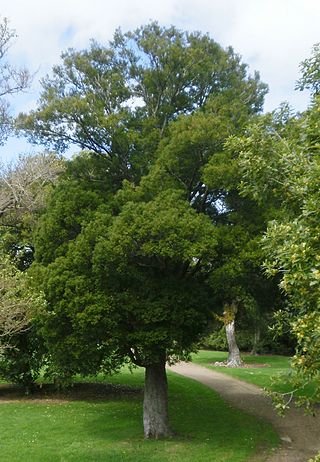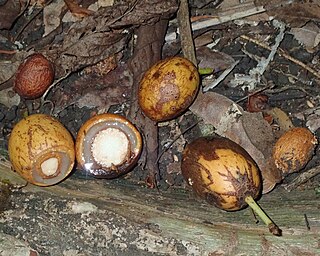
The ruddy shelduck, known in India as the Brahminy duck, is a member of the family Anatidae. It is a distinctive waterfowl, 58 to 70 cm in length with a wingspan of 110 to 135 cm. It has orange-brown body plumage with a paler head, while the tail and the flight feathers in the wings are black, contrasting with the white wing-coverts. It is a migratory bird, wintering in the Indian subcontinent and breeding in southeastern Europe and central Asia, though there are small resident populations in North Africa. It has a loud honking call.

Prumnopitys ferruginea, commonly called miro, is an evergreen coniferous tree which is endemic to New Zealand. Before the genus Prumnopitys was distinguished, it was treated in the related genus Podocarpus as Podocarpus ferrugineus.

Xylopia aethiopica is an evergreen, aromatic tree, of the Annonaceae family that can grow up to 20m high. It is a native to the lowland rainforest and moist fringe forests in the savanna zones of Africa.

Pimenta is a genus of flowering plants in the myrtle family, Myrtaceae described as a genus in 1821. It is native to Central and South America, Mexico, and the West Indies.

Xylopia africana is a species of plant in the Annonaceae family. It is found in west-central Africa. It is restricted to submontane and lower montane forests. It is threatened due to habitat loss by clearance of forest. It was first described as Melodorum africanum in 1862 by George Bentham.

Xylopia is a genus of flowering plants in the family Annonaceae. They are mostly trees and some shrubs. There are about 160 species distributed in Asia, Africa, and the Americas.
Xylopia elliptica is a species of plant in the Annonaceae family. It is grows naturally as a tree in Peninsular Malaysia.
Xylopia magna is a species of plant in the Annonaceae family. It is a tree found in Malaysia and Singapore.
Xylopia pierrei is a tree species in the family Annonaceae and its native range is Thailand to southern Vietnam.

Xylopia frutescens is a tree species the genus Xylopia and family Annonaceae and its native range is S. Mexico to S. Tropical America.

Xylopia aromatica is a species of plant in the Annonaceae family and the accepted name of Xylopia xylopioides.

Lomatia ferruginea, commonly known as fuinque, is a small evergreen tree in the family Proteaceae.

Grains of Selim are the seeds of a shrubby tree, Xylopia aethiopica, found in Africa. The seeds have a musky flavor and are used as a spice in a manner similar to black pepper, and as a flavouring agent that defines café Touba, the dominant style of coffee in Senegal. It is also known as Senegal pepper, Ethiopian pepper, and (historically) Moor pepper and Negro pepper. It also has many names in native languages of Africa, the most common of which is diarr in the Wolof language. It is called 'Etso' in the Ewe language of Ghana and Togo. It is sometimes referred to as African pepper or Guinea pepper, but these are ambiguous terms that may refer to Ashanti pepper and grains of paradise, among others.

Darlingia ferruginea, commonly known as the brown silky oak, is a rainforest tree of the family Proteaceae from Northern Queensland.

Xylopia vielana is a tree species described by Pierre; it is included in the genus Xylopia and family Annonaceae. No subspecies are listed in the Catalogue of Life.
Xylopia benthamii is a species of flowering plant of the genus Xylopia, described by Robert Elias Fries in 1900. It contains one subspecies: Xylopia benthamii dolichopetala. The species is native to Venezuela, Peru, Brazil and Bolivia.
Xylopia discreta is a species of plant in the Annonaceae family. It is native to Brazil, Colombia, French Guiana, Guyana, Suriname, and Venezuela. Carl Linnaeus the Younger, the botanist who first formally described the species using the basionym Unona discreta, named it after its purple, aromatic fruit which set it apart from other members of the family.

Xylopia parviflora is a species of plant in the Annonaceae family. It is native to Bolivia, Brazil, Colombia, Ecuador, French Guiana, Peru and Venezuela. Richard Spruce, the botanist who first formally described the species, named it after its small flowers, though he did not specifically state their size.











